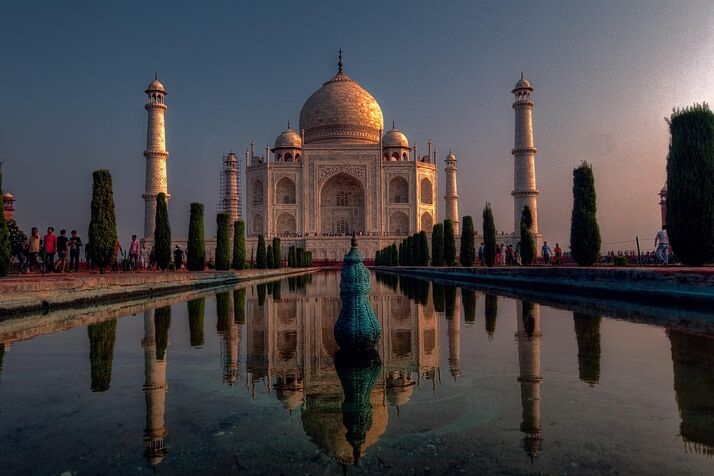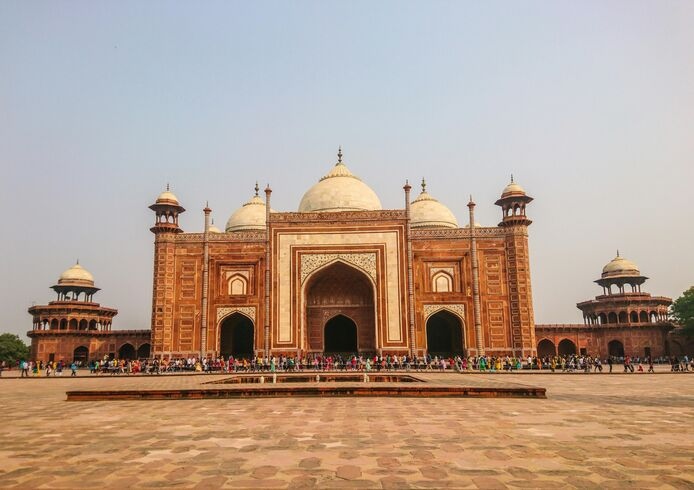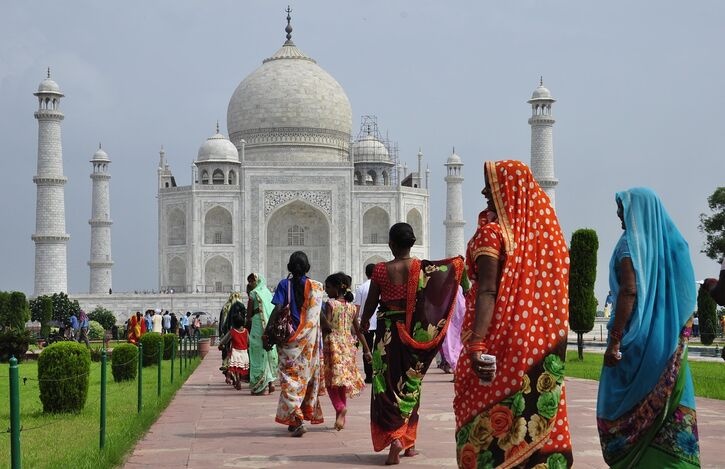You’ve already imagined it a hundred times: that perfect sunrise photo at the Taj Mahal, the white marble glowing pink in the early light, no crowds to spoil your moment. But is dragging yourself out of bed at 4 AM actually worth it?
I’ve done the pre-dawn Taj Mahal visit three times now (yes, glutton for punishment), and I’m going to tell you exactly what those Instagram influencers won’t.
The truth about visiting the Taj Mahal at sunrise is complicated. It’s not the serene, empty experience many travelers expect. But there are legitimate reasons why thousands still set those painful early alarms.
So what’s the real story behind those dreamy sunrise shots? And why might sunset actually be the better option for some travelers?
The Sunrise Experience at the Taj Mahal

What to expect during a sunrise visit
The magic starts well before the actual sunrise. You’ll join a line of eager visitors in the darkness, shuffling through security checks with sleepy eyes and travel mugs of coffee. But trust me – that 4:30 AM alarm will feel worth it the moment you step through the entrance.
As first light breaks, the Taj transforms minute by minute. The marble absorbs the changing light like a chameleon, shifting from ghostly blue-gray to soft pink to a radiant golden glow. It’s like watching a black and white photo slowly develop into full color.
Yes, there will be other people. No, it won’t be the peaceful, solitary experience some Instagram shots suggest. But the crowds at sunrise are significantly thinner than midday madness.
Best viewpoints to capture the changing colors
The classic front-and-center view from the main entrance gives you that symmetrical, postcard-perfect shot. But don’t camp there the whole time.
The gardens to either side offer angles where the rising sun creates dramatic side-lighting on the monument’s intricate details.
For something unique, head to these lesser-known spots:
- The Mehtab Bagh gardens across the river
- The rooftop cafés in Taj Ganj neighborhood
- The small mosque to the west side
Each provides a different perspective as the light changes, giving you variety in your photos that most visitors miss.
Timing: When to arrive for optimal experience
Timing is everything for this show. Here’s the breakdown:
| Season | Arrival Time | Sunrise Time | Gates Open |
|---|---|---|---|
| Winter | 6:00 AM | 6:45-7:15 AM | 6:30 AM |
| Summer | 5:00 AM | 5:30-6:00 AM | 5:30 AM |
Arrive at least 45 minutes before the official opening time. You’ll want to be among the first through the gates to secure prime viewing spots.
The absolute golden period happens about 10-15 minutes after the sun clears the horizon. That’s when the marble glows most dramatically and the light is perfect for photography.
Weather considerations for the perfect sunrise viewing

Winter mornings often bring fog along the Yamuna River, creating an ethereal atmosphere as the Taj emerges from the mist. December through February can deliver the most dramatic sunrise scenes, but unpredictable fog might completely obscure the monument.
Monsoon season (July-September) offers moody, dramatic skies but higher chances of rainfall ruining your plans.
The clearest views typically come during October-November and February-March when the air pollution is lower and fog is less common.
Check the weather forecast the night before. If it predicts heavy fog or rain, consider rescheduling your visit or be prepared for a different kind of beauty – one where the Taj plays peekaboo through atmospheric conditions.
For a guided tour for Taj Mahal at Sunrise please check 5 Senses Tours.
Behind the Popularity of Dawn Visits
A. Historical significance of seeing the Taj at first light
The Mughals knew what they were doing when they designed the Taj Mahal. They planned it specifically to be viewed as the first rays of dawn hit its white marble.
Shah Jahan wanted visitors to witness how the monument transforms with the changing light. At sunrise, the Taj shifts from a subtle pink glow to brilliant white as the sun climbs higher. This isn’t just pretty – it’s spiritual. The changing colors symbolize the soul’s journey and the passing of time.
Ancient visitors considered sunrise viewing almost mandatory. The morning light was thought to bring blessings, with many pilgrims traveling for months just to experience this sacred moment.
B. How social media has amplified the sunrise experience
Instagram changed everything for the Taj at sunrise.
What was once a quiet spiritual experience has become the ultimate trophy shot. In 2015, approximately 20,000 sunrise photos of the Taj were shared online. By 2023, that number exploded to over 5 million.
That perfect shot of the Taj bathed in golden light has become a bucket-list moment. Travel influencers have created an entire genre of content around the “Taj sunrise experience,” with specific poses, locations, and filters becoming part of the ritual.
C. Celebrity endorsements and famous sunrise photographs
When Mark Zuckerberg visited in 2015 and posted his sunrise Taj photo, bookings for dawn tours jumped 300% the following month.
Then came the wave: Princess Kate and Prince William’s iconic bench photo, Oprah’s meditation session on the east gardens at dawn, and Tom Cruise’s famous running shot with the sunrise Taj in the background.
Steve McCurry’s National Geographic sunrise photo of the Taj might be the most influential image ever taken of the monument. That single photograph from 1984 still drives thousands of photographers to attempt to recreate it every year.
Practical Considerations for Early Morning Visits

A. Ticket information and special sunrise packages
The Taj Mahal opens 30 minutes before sunrise, which means timing changes throughout the year. Standard entry tickets cost ₹1,100 for foreign tourists and ₹50 for Indian nationals. But here’s what most travel blogs won’t tell you – there are special sunrise packages available that can save you precious time in those early morning queues.
Several tour operators offer “Skip-the-Line” sunrise packages for around ₹2,500-3,500 per person. Worth every rupee? Absolutely, especially during peak season when lines start forming well before opening time.
B. Transportation options in the early hours
Getting to the Taj at 5:30 AM isn’t as impossible as it sounds. Your options:
- Pre-booked taxis: Most reliable, expect to pay ₹400-600 from central Agra
- Auto-rickshaws: Available from 4:30 AM onwards, negotiate your fare (₹150-250)
- Hotel shuttles: Many hotels offer this service for free or minimal cost
The roads are eerily quiet at this hour, and your journey typically takes 15-20 minutes from central Agra – half the time it would take during daytime traffic.
C. What to bring: Essential items for comfort
Sunrise visits demand specific preparation:
- A light jacket or shawl (mornings are surprisingly chilly, even in summer)
- Mosquito repellent (those dawn bugs are relentless)
- Fully charged phone/camera (the lighting changes quickly)
- Small flashlight (pathways aren’t well-lit before sunrise)
- Water bottle (none available inside until shops open)
- Cash in small denominations (for unexpected expenses)
D. Crowds: Reality vs. expectations
The “beat-the-crowds” promise of sunrise visits? Partially true.
Yes, you’ll encounter fewer people than midday madness, but you won’t have the place to yourself. Expect 100-200 early birds, mostly photographers claiming prime spots. The East Gate typically has shorter lines than the West Gate.
The real advantage isn’t necessarily fewer people – it’s that everyone is quieter, more respectful, and focused on the experience rather than selfies.
E. Security procedures and entry protocols
Security at the Taj is no joke, especially at sunrise when staff are extra vigilant:
- Lines move slower as security personnel are thorough
- No tripods allowed (though monopods sometimes slip through)
- Food, smoking materials, and large bags prohibited
- Expect two security checks: initial screening, then bag/body check
Pro tip: Women often move through security faster as they have separate, typically shorter lines. Consider splitting up your group temporarily if mixed-gender.
For immersive culture walks in India visit 5 senses walks.
Alternatives to Consider
A. Sunset views as a comparable alternative
Look, everyone raves about sunrise at the Taj, but can we talk about sunset for a second? The evening light bathes those white marble domes in a golden-pink glow that’s absolutely mesmerizing. And the best part? You won’t need to drag yourself out of bed at 4 AM!
The crowds thin out considerably by late afternoon, giving you space to breathe and actually enjoy the monument without someone’s selfie stick in your face. Many photographers actually prefer the sunset light—it creates this dramatic shadow play across the intricate carvings that you completely miss in the morning.
B. Moonlight viewings on full moon nights
Ever seen the Taj under a full moon? It’s like stepping into another world. For five nights around each full moon (two days before, the full moon night, and two days after), the Taj opens for night viewing. The marble literally glows under moonlight—it’s not an exaggeration.
These tickets are limited to just 400 people per night and must be purchased a day in advance. Yes, it’s a bit of planning, but imagine having the Taj almost to yourself, bathed in silvery light. The reflection on the pools creates this ethereal double-image that no daytime visit can match.
C. Visiting during different seasons for varied experiences
The Taj isn’t a one-season wonder. Each time of year transforms it:
- Winter (November-February): Clear skies make for stunning photos, but morning fog can create mysterious, dreamy vistas if you’re lucky.
- Monsoon (July-September): The gardens burst with life, and rain-washed marble shines brilliantly when the sun peeks through clouds.
- Spring (March-April): Perfect moderate temperatures and blooming gardens make for comfortable exploring.
Summer might be sweltering, but the mangoes are amazing and the tourist crowds noticeably thinner. Why not plan repeat visits? The Taj is never quite the same twice.
For a podcast on planning travel to India, visit Incredible India Travel.
The Verdict: Is It Worth Waking Up Early?

A. Value assessment: Experience vs. effort
Is dragging yourself out of bed at 4:30 AM worth it just to see a building? That’s the million-dollar question.
Here’s the straight talk: sunrise at the Taj Mahal transforms a tourist attraction into a spiritual experience. The first golden rays hitting those white marble domes create a color show that no Instagram filter can replicate. The crowds are thinner, the air is cooler, and there’s a certain magic to watching India wake up around this wonder.
But let’s not sugarcoat the effort. You’re sacrificing sleep, dealing with pre-dawn darkness in an unfamiliar city, and likely paying premium rates for early transport. Plus, during foggy winter mornings (December-January), you might see nothing but mist.
B. Comparing sunrise visits with regular daytime experiences
| Aspect | Sunrise Visit | Regular Daytime Visit |
|---|---|---|
| Crowds | 30-50% fewer people | Packed by 9 AM |
| Photography | Soft golden light, magical glow | Harsh shadows, challenging shots |
| Temperature | Cool, comfortable | Hot, especially April-September |
| Energy Required | Early wake-up, possibly tired later | Normal schedule, more energy |
| Price | Same entry fee, but pricier transport | Standard rates for everything |
The daytime experience gives you better logistics and visibility of details, but sunrise offers an almost private audience with the Taj.
C. Who should definitely make the sunrise trip
Photography enthusiasts, this is your moment. Period. The lighting conditions are unbeatable.
You should also drag yourself out of bed if you’re a contemplative traveler who values moments of quiet wonder, hate crowds with a passion, or are visiting during India’s scorching summer months when morning coolness is golden.
If this is a once-in-a-lifetime trip to India, the sunrise Taj experience adds that extra layer of memory that justifies the bleary eyes.
For a guided tour for Taj Mahal at Sunrise please check 5 Senses Tours.
D. When to skip the dawn experience
Don’t bother with sunrise visits during heavy fog season (late December to early February) unless you enjoy photographing white blobs in mist.
If you’re traveling with young kids or people who turn into grumpy monsters without proper sleep, the experience won’t be worth the family tension.
Also, if you’re on a tight schedule with just one day in Agra, choosing sunrise might leave you too exhausted to enjoy other sights like Agra Fort or Fatehpur Sikri later in the day.
The bottom line? Sunrise at the Taj isn’t just hype – it’s magnificent. But it’s not for everyone, and that’s perfectly okay.
Visiting the Taj Mahal at sunrise offers a magical experience that truly lives up to the hype. The soft golden light illuminating the white marble, smaller crowds allowing for better photos, and the serene atmosphere make dawn visits special. While early morning visits require planning ahead, navigating potential fog during winter months, and dealing with sleepiness, the rewards far outweigh these minor inconveniences.
For travelers seeking the most memorable Taj Mahal experience, the sunrise visit remains unmatched. Whether you’re a photographer, a romantic, or simply someone who appreciates witnessing world wonders in their best light, set that alarm clock and make the early journey. The timeless beauty of the Taj Mahal bathed in the day’s first light is a travel moment that will stay with you long after your trip to India has ended.
For an ultimate guide to planning an India tour, visit Great Holiday Ideas
Discover more from Great Holiday Ideas
Subscribe to get the latest posts sent to your email.